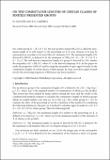Files in this item
On the commutator lengths of certain classes of finitely presented groups
Item metadata
| dc.contributor.author | Doostie, H. | |
| dc.contributor.author | Campbell, P.P. | |
| dc.date.accessioned | 2014-05-07T11:01:03Z | |
| dc.date.available | 2014-05-07T11:01:03Z | |
| dc.date.issued | 2006 | |
| dc.identifier | 116545106 | |
| dc.identifier | f9c3224a-36d8-49de-b845-f78d3342a7da | |
| dc.identifier | 33749513941 | |
| dc.identifier.citation | Doostie , H & Campbell , P P 2006 , ' On the commutator lengths of certain classes of finitely presented groups ' , International Journal of Mathematics and Mathematical Sciences , vol. 2006 , 74981 . https://doi.org/10.1155/IJMMS/2006/74981 | en |
| dc.identifier.issn | 0161-1712 | |
| dc.identifier.uri | https://hdl.handle.net/10023/4719 | |
| dc.description.abstract | For a finite group G = 〈X〉 (X ≠ G), the least positive integer ML(G) is called the maximum length of G with respect to the generating set X if every element of G maybe represented as a product of at most ML(G) elements of X. The maximum length of G, denoted by ML (G), is defined to be the minimum of {ML(G) G = 〈X〉, X ≠ G, X ≠ G - {1}}. The well-known commutator length of a group G, denoted by c (G), satisfies the inequality c (G) ≤ ML(G′), where G′ is the derived subgroup of G. In this paper we study the properties of ML (G) and by using this inequality we give upper bounds for the commutator lengths of certain classes of finite groups. In some cases these upper bounds involve the interesting sequences of Fibonacci and Lucas numbers. | |
| dc.format.extent | 9 | |
| dc.format.extent | 1913658 | |
| dc.language.iso | eng | |
| dc.relation.ispartof | International Journal of Mathematics and Mathematical Sciences | en |
| dc.subject | QA Mathematics | en |
| dc.subject.lcc | QA | en |
| dc.title | On the commutator lengths of certain classes of finitely presented groups | en |
| dc.type | Journal article | en |
| dc.contributor.institution | University of St Andrews. School of Mathematics and Statistics | en |
| dc.identifier.doi | https://doi.org/10.1155/IJMMS/2006/74981 | |
| dc.description.status | Peer reviewed | en |
| dc.identifier.url | http://www.scopus.com/inward/record.url?eid=2-s2.0-33749513941&partnerID=8YFLogxK | en |
This item appears in the following Collection(s)
Items in the St Andrews Research Repository are protected by copyright, with all rights reserved, unless otherwise indicated.

